The Fast Food Industry: Competitive Rivalry and Key Drivers Analysis
VerifiedAdded on 2020/01/28
|8
|2220
|154
Report
AI Summary
This report provides a detailed analysis of the competitive forces within the fast food industry, focusing on the UK market. It begins by examining the 'Competitive Rivalry' force through the lens of Porter's Five Forces, considering factors like the number of firms, their aggressiveness, and switching costs. The report then delves into the 'Key Drivers of Change' derived from a PESTEL analysis, highlighting the impact of political, economic, social, technological, environmental, and legal factors. Economic and social factors, such as GDP trends, obesity concerns, and evolving consumer preferences, are emphasized as critical drivers. The analysis also considers the effects of Brexit and changing legal frameworks on the industry. The report concludes by underscoring the importance of strategic adaptation in response to these dynamic forces.

CONSIDERATION OF THE ‘COMPETITIVE RIVALRY’
FORCE OF PORTERS FIVE FORCES AND CONSIDERATION
OF THE ‘KEY DRIVERS OF CHANGE’ DEVELOPED FROM
THE PESTEL ANALYSIS
1
FORCE OF PORTERS FIVE FORCES AND CONSIDERATION
OF THE ‘KEY DRIVERS OF CHANGE’ DEVELOPED FROM
THE PESTEL ANALYSIS
1
Paraphrase This Document
Need a fresh take? Get an instant paraphrase of this document with our AI Paraphraser
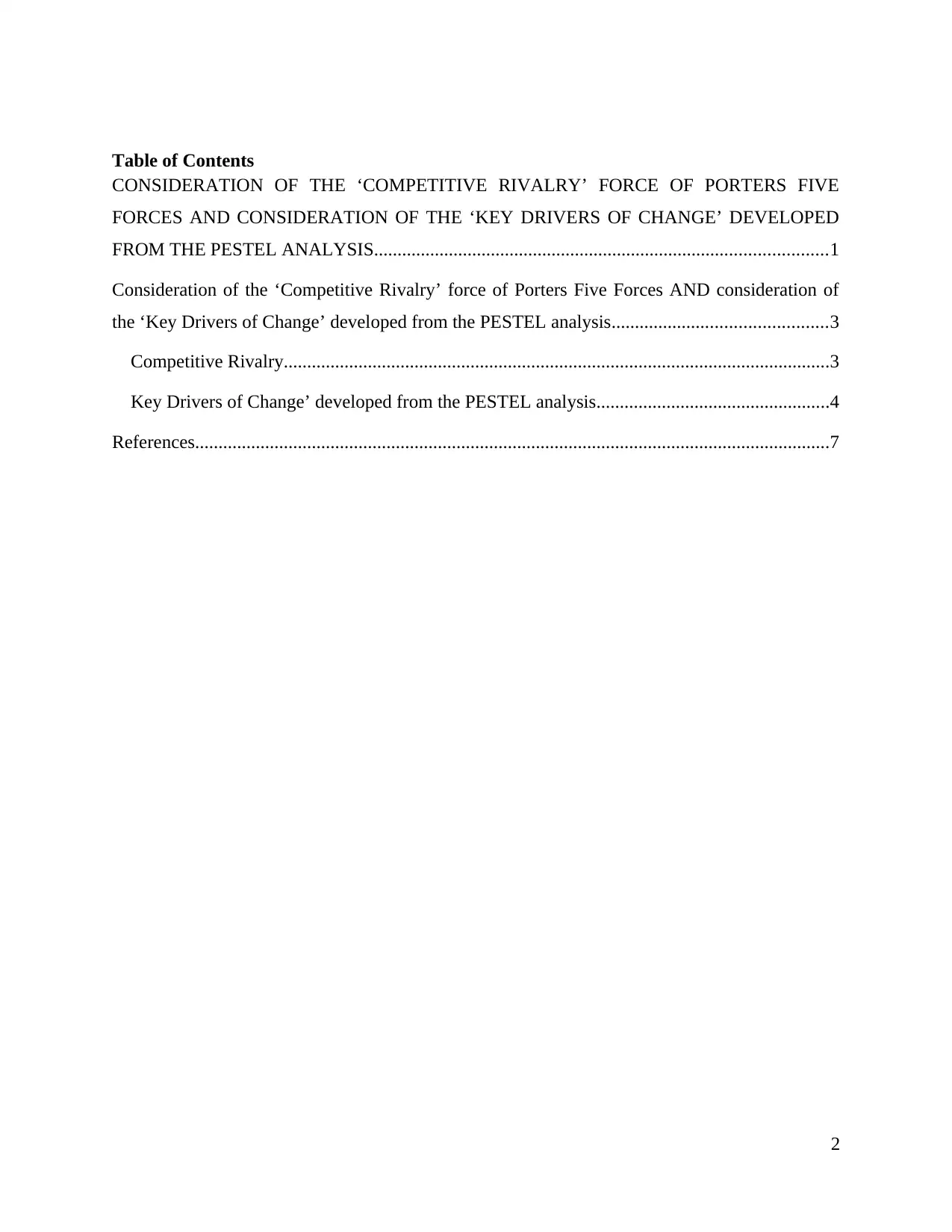
Table of Contents
CONSIDERATION OF THE ‘COMPETITIVE RIVALRY’ FORCE OF PORTERS FIVE
FORCES AND CONSIDERATION OF THE ‘KEY DRIVERS OF CHANGE’ DEVELOPED
FROM THE PESTEL ANALYSIS.................................................................................................1
Consideration of the ‘Competitive Rivalry’ force of Porters Five Forces AND consideration of
the ‘Key Drivers of Change’ developed from the PESTEL analysis..............................................3
Competitive Rivalry.....................................................................................................................3
Key Drivers of Change’ developed from the PESTEL analysis..................................................4
References........................................................................................................................................7
2
CONSIDERATION OF THE ‘COMPETITIVE RIVALRY’ FORCE OF PORTERS FIVE
FORCES AND CONSIDERATION OF THE ‘KEY DRIVERS OF CHANGE’ DEVELOPED
FROM THE PESTEL ANALYSIS.................................................................................................1
Consideration of the ‘Competitive Rivalry’ force of Porters Five Forces AND consideration of
the ‘Key Drivers of Change’ developed from the PESTEL analysis..............................................3
Competitive Rivalry.....................................................................................................................3
Key Drivers of Change’ developed from the PESTEL analysis..................................................4
References........................................................................................................................................7
2
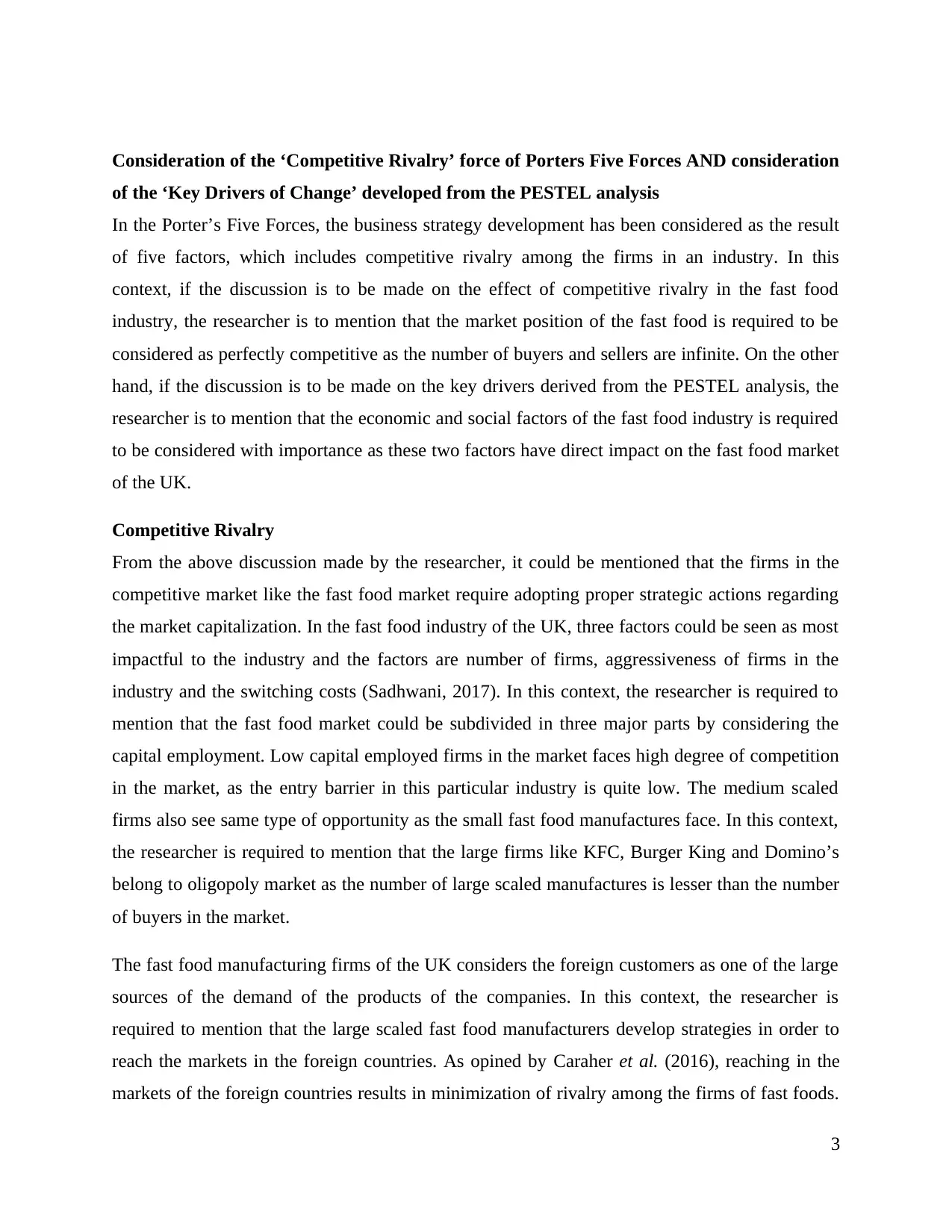
Consideration of the ‘Competitive Rivalry’ force of Porters Five Forces AND consideration
of the ‘Key Drivers of Change’ developed from the PESTEL analysis
In the Porter’s Five Forces, the business strategy development has been considered as the result
of five factors, which includes competitive rivalry among the firms in an industry. In this
context, if the discussion is to be made on the effect of competitive rivalry in the fast food
industry, the researcher is to mention that the market position of the fast food is required to be
considered as perfectly competitive as the number of buyers and sellers are infinite. On the other
hand, if the discussion is to be made on the key drivers derived from the PESTEL analysis, the
researcher is to mention that the economic and social factors of the fast food industry is required
to be considered with importance as these two factors have direct impact on the fast food market
of the UK.
Competitive Rivalry
From the above discussion made by the researcher, it could be mentioned that the firms in the
competitive market like the fast food market require adopting proper strategic actions regarding
the market capitalization. In the fast food industry of the UK, three factors could be seen as most
impactful to the industry and the factors are number of firms, aggressiveness of firms in the
industry and the switching costs (Sadhwani, 2017). In this context, the researcher is required to
mention that the fast food market could be subdivided in three major parts by considering the
capital employment. Low capital employed firms in the market faces high degree of competition
in the market, as the entry barrier in this particular industry is quite low. The medium scaled
firms also see same type of opportunity as the small fast food manufactures face. In this context,
the researcher is required to mention that the large firms like KFC, Burger King and Domino’s
belong to oligopoly market as the number of large scaled manufactures is lesser than the number
of buyers in the market.
The fast food manufacturing firms of the UK considers the foreign customers as one of the large
sources of the demand of the products of the companies. In this context, the researcher is
required to mention that the large scaled fast food manufacturers develop strategies in order to
reach the markets in the foreign countries. As opined by Caraher et al. (2016), reaching in the
markets of the foreign countries results in minimization of rivalry among the firms of fast foods.
3
of the ‘Key Drivers of Change’ developed from the PESTEL analysis
In the Porter’s Five Forces, the business strategy development has been considered as the result
of five factors, which includes competitive rivalry among the firms in an industry. In this
context, if the discussion is to be made on the effect of competitive rivalry in the fast food
industry, the researcher is to mention that the market position of the fast food is required to be
considered as perfectly competitive as the number of buyers and sellers are infinite. On the other
hand, if the discussion is to be made on the key drivers derived from the PESTEL analysis, the
researcher is to mention that the economic and social factors of the fast food industry is required
to be considered with importance as these two factors have direct impact on the fast food market
of the UK.
Competitive Rivalry
From the above discussion made by the researcher, it could be mentioned that the firms in the
competitive market like the fast food market require adopting proper strategic actions regarding
the market capitalization. In the fast food industry of the UK, three factors could be seen as most
impactful to the industry and the factors are number of firms, aggressiveness of firms in the
industry and the switching costs (Sadhwani, 2017). In this context, the researcher is required to
mention that the fast food market could be subdivided in three major parts by considering the
capital employment. Low capital employed firms in the market faces high degree of competition
in the market, as the entry barrier in this particular industry is quite low. The medium scaled
firms also see same type of opportunity as the small fast food manufactures face. In this context,
the researcher is required to mention that the large firms like KFC, Burger King and Domino’s
belong to oligopoly market as the number of large scaled manufactures is lesser than the number
of buyers in the market.
The fast food manufacturing firms of the UK considers the foreign customers as one of the large
sources of the demand of the products of the companies. In this context, the researcher is
required to mention that the large scaled fast food manufacturers develop strategies in order to
reach the markets in the foreign countries. As opined by Caraher et al. (2016), reaching in the
markets of the foreign countries results in minimization of rivalry among the firms of fast foods.
3
⊘ This is a preview!⊘
Do you want full access?
Subscribe today to unlock all pages.

Trusted by 1+ million students worldwide
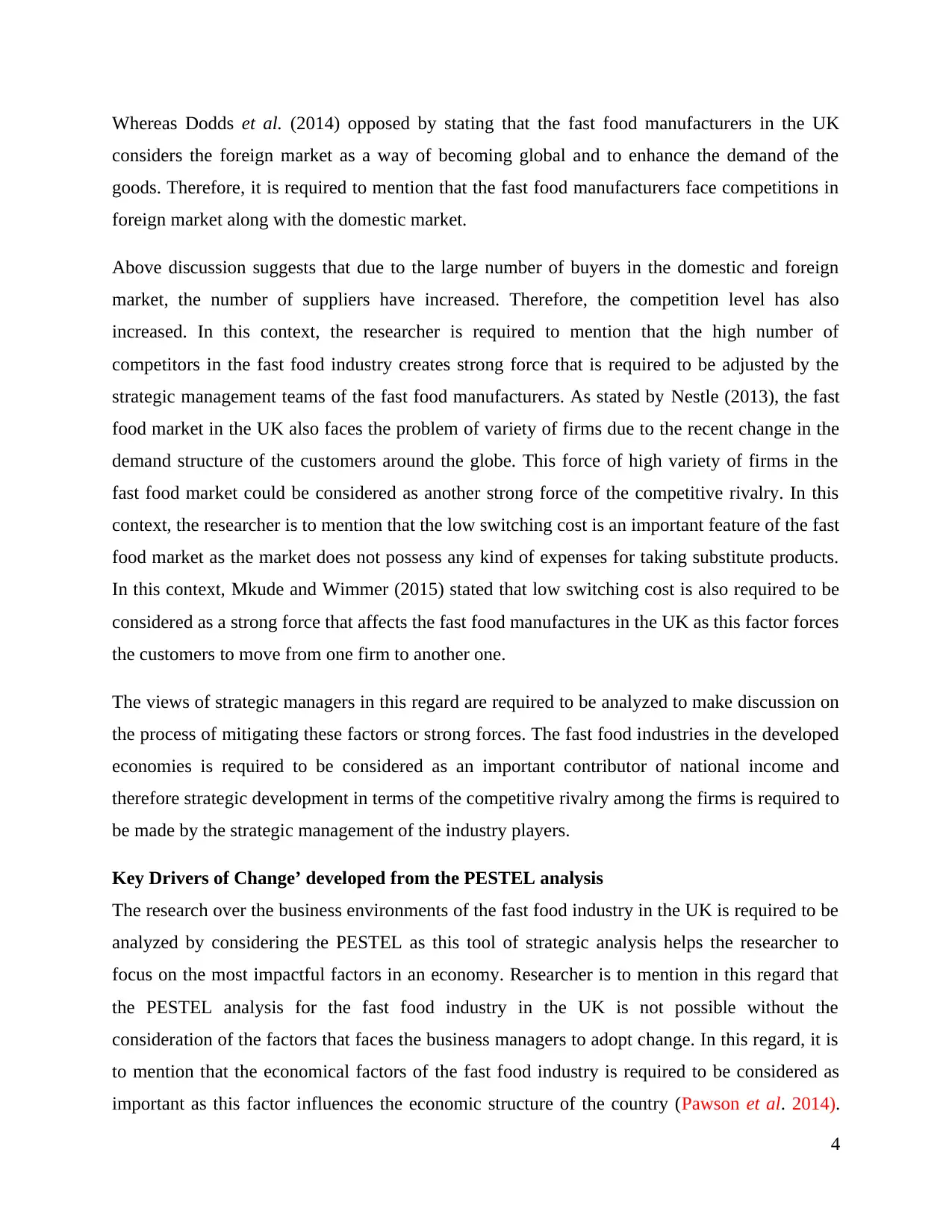
Whereas Dodds et al. (2014) opposed by stating that the fast food manufacturers in the UK
considers the foreign market as a way of becoming global and to enhance the demand of the
goods. Therefore, it is required to mention that the fast food manufacturers face competitions in
foreign market along with the domestic market.
Above discussion suggests that due to the large number of buyers in the domestic and foreign
market, the number of suppliers have increased. Therefore, the competition level has also
increased. In this context, the researcher is required to mention that the high number of
competitors in the fast food industry creates strong force that is required to be adjusted by the
strategic management teams of the fast food manufacturers. As stated by Nestle (2013), the fast
food market in the UK also faces the problem of variety of firms due to the recent change in the
demand structure of the customers around the globe. This force of high variety of firms in the
fast food market could be considered as another strong force of the competitive rivalry. In this
context, the researcher is to mention that the low switching cost is an important feature of the fast
food market as the market does not possess any kind of expenses for taking substitute products.
In this context, Mkude and Wimmer (2015) stated that low switching cost is also required to be
considered as a strong force that affects the fast food manufactures in the UK as this factor forces
the customers to move from one firm to another one.
The views of strategic managers in this regard are required to be analyzed to make discussion on
the process of mitigating these factors or strong forces. The fast food industries in the developed
economies is required to be considered as an important contributor of national income and
therefore strategic development in terms of the competitive rivalry among the firms is required to
be made by the strategic management of the industry players.
Key Drivers of Change’ developed from the PESTEL analysis
The research over the business environments of the fast food industry in the UK is required to be
analyzed by considering the PESTEL as this tool of strategic analysis helps the researcher to
focus on the most impactful factors in an economy. Researcher is to mention in this regard that
the PESTEL analysis for the fast food industry in the UK is not possible without the
consideration of the factors that faces the business managers to adopt change. In this regard, it is
to mention that the economical factors of the fast food industry is required to be considered as
important as this factor influences the economic structure of the country (Pawson et al. 2014).
4
considers the foreign market as a way of becoming global and to enhance the demand of the
goods. Therefore, it is required to mention that the fast food manufacturers face competitions in
foreign market along with the domestic market.
Above discussion suggests that due to the large number of buyers in the domestic and foreign
market, the number of suppliers have increased. Therefore, the competition level has also
increased. In this context, the researcher is required to mention that the high number of
competitors in the fast food industry creates strong force that is required to be adjusted by the
strategic management teams of the fast food manufacturers. As stated by Nestle (2013), the fast
food market in the UK also faces the problem of variety of firms due to the recent change in the
demand structure of the customers around the globe. This force of high variety of firms in the
fast food market could be considered as another strong force of the competitive rivalry. In this
context, the researcher is to mention that the low switching cost is an important feature of the fast
food market as the market does not possess any kind of expenses for taking substitute products.
In this context, Mkude and Wimmer (2015) stated that low switching cost is also required to be
considered as a strong force that affects the fast food manufactures in the UK as this factor forces
the customers to move from one firm to another one.
The views of strategic managers in this regard are required to be analyzed to make discussion on
the process of mitigating these factors or strong forces. The fast food industries in the developed
economies is required to be considered as an important contributor of national income and
therefore strategic development in terms of the competitive rivalry among the firms is required to
be made by the strategic management of the industry players.
Key Drivers of Change’ developed from the PESTEL analysis
The research over the business environments of the fast food industry in the UK is required to be
analyzed by considering the PESTEL as this tool of strategic analysis helps the researcher to
focus on the most impactful factors in an economy. Researcher is to mention in this regard that
the PESTEL analysis for the fast food industry in the UK is not possible without the
consideration of the factors that faces the business managers to adopt change. In this regard, it is
to mention that the economical factors of the fast food industry is required to be considered as
important as this factor influences the economic structure of the country (Pawson et al. 2014).
4
Paraphrase This Document
Need a fresh take? Get an instant paraphrase of this document with our AI Paraphraser
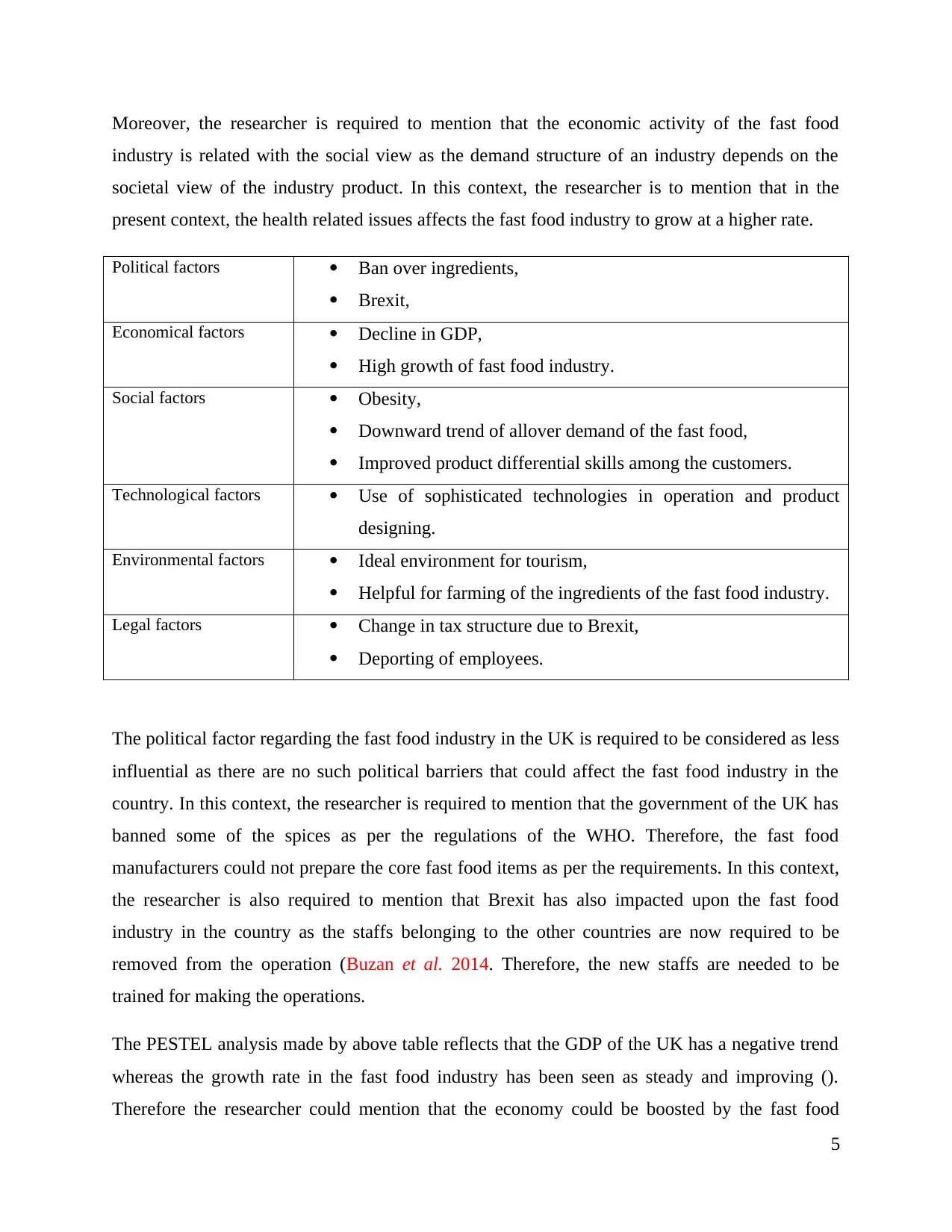
Moreover, the researcher is required to mention that the economic activity of the fast food
industry is related with the social view as the demand structure of an industry depends on the
societal view of the industry product. In this context, the researcher is to mention that in the
present context, the health related issues affects the fast food industry to grow at a higher rate.
Political factors Ban over ingredients,
Brexit,
Economical factors Decline in GDP,
High growth of fast food industry.
Social factors Obesity,
Downward trend of allover demand of the fast food,
Improved product differential skills among the customers.
Technological factors Use of sophisticated technologies in operation and product
designing.
Environmental factors Ideal environment for tourism,
Helpful for farming of the ingredients of the fast food industry.
Legal factors Change in tax structure due to Brexit,
Deporting of employees.
The political factor regarding the fast food industry in the UK is required to be considered as less
influential as there are no such political barriers that could affect the fast food industry in the
country. In this context, the researcher is required to mention that the government of the UK has
banned some of the spices as per the regulations of the WHO. Therefore, the fast food
manufacturers could not prepare the core fast food items as per the requirements. In this context,
the researcher is also required to mention that Brexit has also impacted upon the fast food
industry in the country as the staffs belonging to the other countries are now required to be
removed from the operation (Buzan et al. 2014. Therefore, the new staffs are needed to be
trained for making the operations.
The PESTEL analysis made by above table reflects that the GDP of the UK has a negative trend
whereas the growth rate in the fast food industry has been seen as steady and improving ().
Therefore the researcher could mention that the economy could be boosted by the fast food
5
industry is related with the social view as the demand structure of an industry depends on the
societal view of the industry product. In this context, the researcher is to mention that in the
present context, the health related issues affects the fast food industry to grow at a higher rate.
Political factors Ban over ingredients,
Brexit,
Economical factors Decline in GDP,
High growth of fast food industry.
Social factors Obesity,
Downward trend of allover demand of the fast food,
Improved product differential skills among the customers.
Technological factors Use of sophisticated technologies in operation and product
designing.
Environmental factors Ideal environment for tourism,
Helpful for farming of the ingredients of the fast food industry.
Legal factors Change in tax structure due to Brexit,
Deporting of employees.
The political factor regarding the fast food industry in the UK is required to be considered as less
influential as there are no such political barriers that could affect the fast food industry in the
country. In this context, the researcher is required to mention that the government of the UK has
banned some of the spices as per the regulations of the WHO. Therefore, the fast food
manufacturers could not prepare the core fast food items as per the requirements. In this context,
the researcher is also required to mention that Brexit has also impacted upon the fast food
industry in the country as the staffs belonging to the other countries are now required to be
removed from the operation (Buzan et al. 2014. Therefore, the new staffs are needed to be
trained for making the operations.
The PESTEL analysis made by above table reflects that the GDP of the UK has a negative trend
whereas the growth rate in the fast food industry has been seen as steady and improving ().
Therefore the researcher could mention that the economy could be boosted by the fast food
5
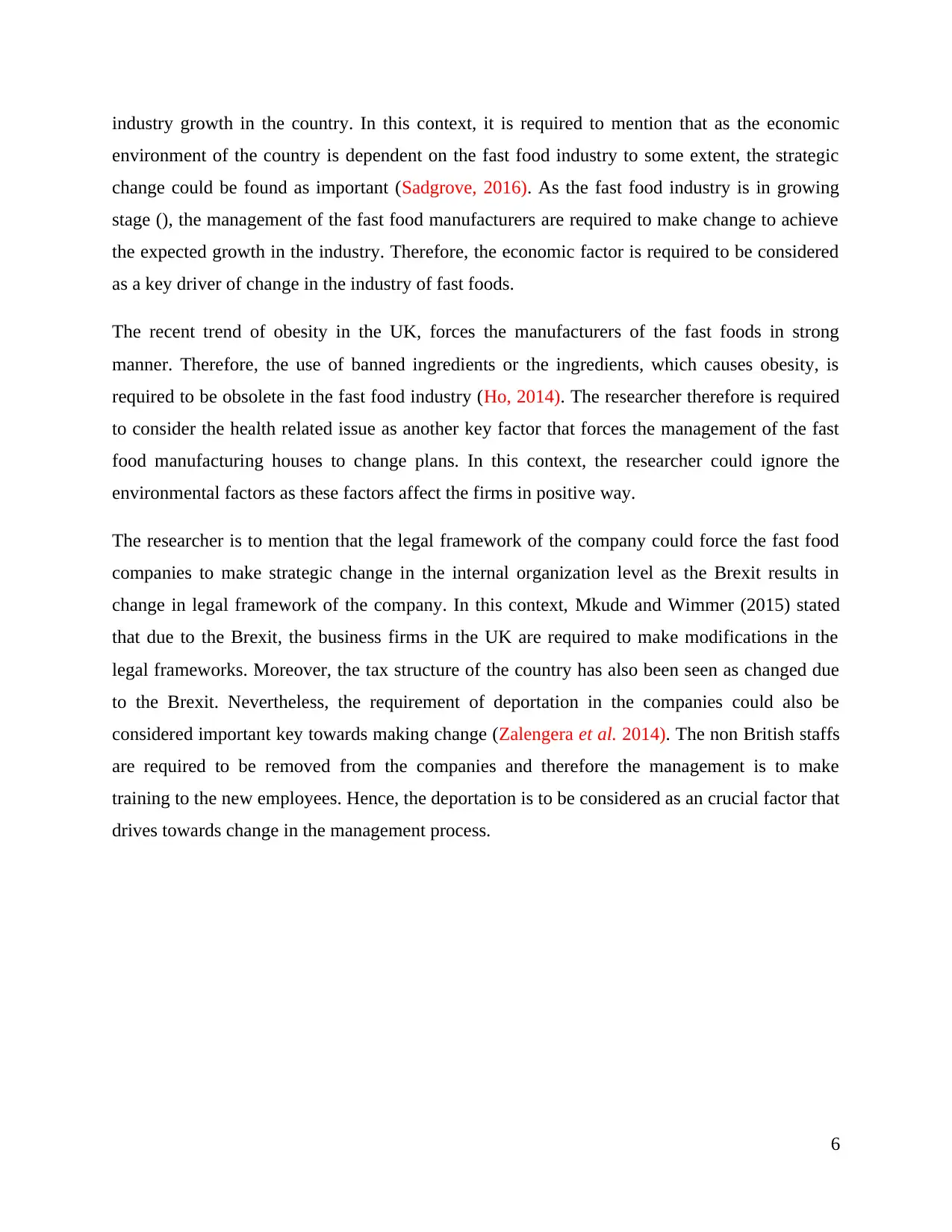
industry growth in the country. In this context, it is required to mention that as the economic
environment of the country is dependent on the fast food industry to some extent, the strategic
change could be found as important (Sadgrove, 2016). As the fast food industry is in growing
stage (), the management of the fast food manufacturers are required to make change to achieve
the expected growth in the industry. Therefore, the economic factor is required to be considered
as a key driver of change in the industry of fast foods.
The recent trend of obesity in the UK, forces the manufacturers of the fast foods in strong
manner. Therefore, the use of banned ingredients or the ingredients, which causes obesity, is
required to be obsolete in the fast food industry (Ho, 2014). The researcher therefore is required
to consider the health related issue as another key factor that forces the management of the fast
food manufacturing houses to change plans. In this context, the researcher could ignore the
environmental factors as these factors affect the firms in positive way.
The researcher is to mention that the legal framework of the company could force the fast food
companies to make strategic change in the internal organization level as the Brexit results in
change in legal framework of the company. In this context, Mkude and Wimmer (2015) stated
that due to the Brexit, the business firms in the UK are required to make modifications in the
legal frameworks. Moreover, the tax structure of the country has also been seen as changed due
to the Brexit. Nevertheless, the requirement of deportation in the companies could also be
considered important key towards making change (Zalengera et al. 2014). The non British staffs
are required to be removed from the companies and therefore the management is to make
training to the new employees. Hence, the deportation is to be considered as an crucial factor that
drives towards change in the management process.
6
environment of the country is dependent on the fast food industry to some extent, the strategic
change could be found as important (Sadgrove, 2016). As the fast food industry is in growing
stage (), the management of the fast food manufacturers are required to make change to achieve
the expected growth in the industry. Therefore, the economic factor is required to be considered
as a key driver of change in the industry of fast foods.
The recent trend of obesity in the UK, forces the manufacturers of the fast foods in strong
manner. Therefore, the use of banned ingredients or the ingredients, which causes obesity, is
required to be obsolete in the fast food industry (Ho, 2014). The researcher therefore is required
to consider the health related issue as another key factor that forces the management of the fast
food manufacturing houses to change plans. In this context, the researcher could ignore the
environmental factors as these factors affect the firms in positive way.
The researcher is to mention that the legal framework of the company could force the fast food
companies to make strategic change in the internal organization level as the Brexit results in
change in legal framework of the company. In this context, Mkude and Wimmer (2015) stated
that due to the Brexit, the business firms in the UK are required to make modifications in the
legal frameworks. Moreover, the tax structure of the country has also been seen as changed due
to the Brexit. Nevertheless, the requirement of deportation in the companies could also be
considered important key towards making change (Zalengera et al. 2014). The non British staffs
are required to be removed from the companies and therefore the management is to make
training to the new employees. Hence, the deportation is to be considered as an crucial factor that
drives towards change in the management process.
6
⊘ This is a preview!⊘
Do you want full access?
Subscribe today to unlock all pages.

Trusted by 1+ million students worldwide
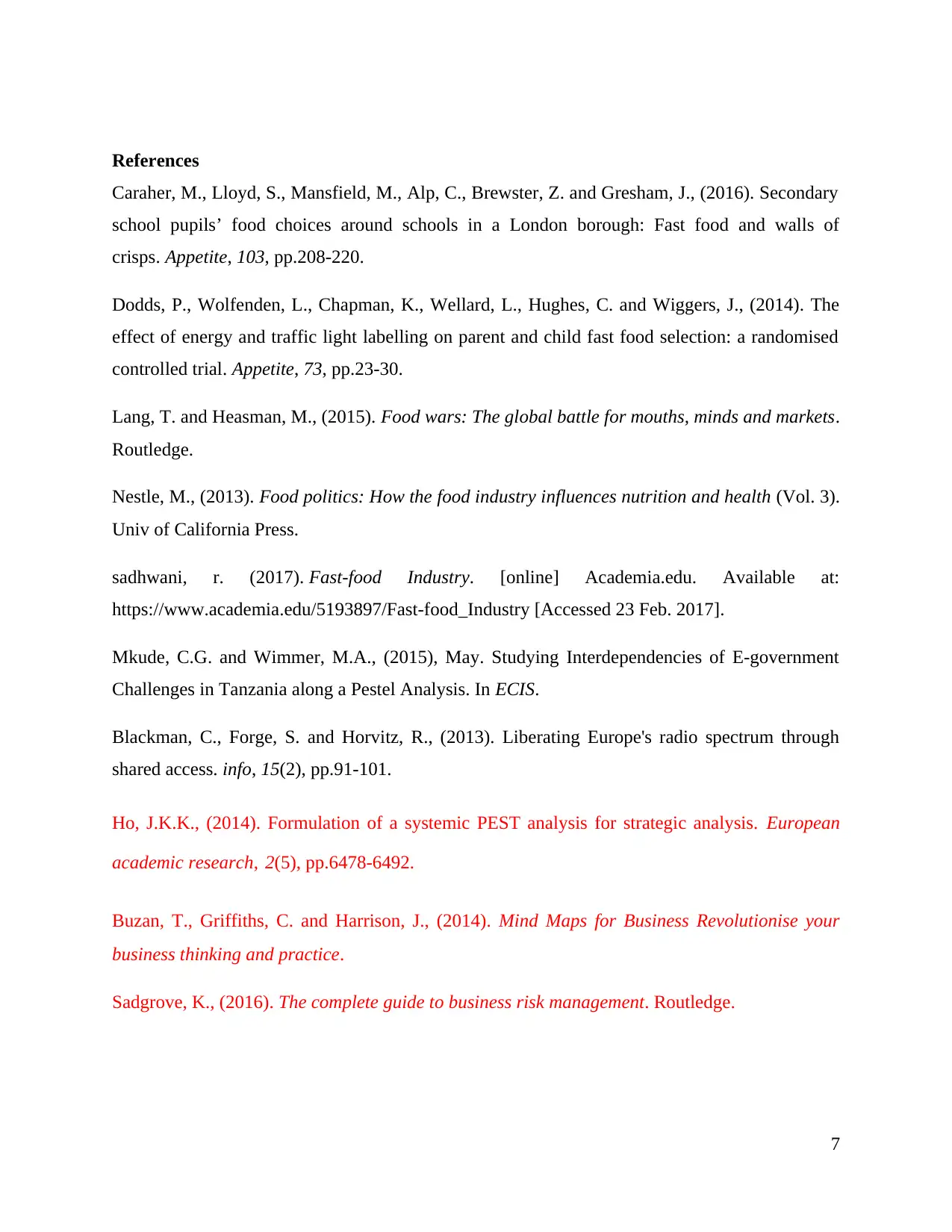
References
Caraher, M., Lloyd, S., Mansfield, M., Alp, C., Brewster, Z. and Gresham, J., (2016). Secondary
school pupils’ food choices around schools in a London borough: Fast food and walls of
crisps. Appetite, 103, pp.208-220.
Dodds, P., Wolfenden, L., Chapman, K., Wellard, L., Hughes, C. and Wiggers, J., (2014). The
effect of energy and traffic light labelling on parent and child fast food selection: a randomised
controlled trial. Appetite, 73, pp.23-30.
Lang, T. and Heasman, M., (2015). Food wars: The global battle for mouths, minds and markets.
Routledge.
Nestle, M., (2013). Food politics: How the food industry influences nutrition and health (Vol. 3).
Univ of California Press.
sadhwani, r. (2017). Fast-food Industry. [online] Academia.edu. Available at:
https://www.academia.edu/5193897/Fast-food_Industry [Accessed 23 Feb. 2017].
Mkude, C.G. and Wimmer, M.A., (2015), May. Studying Interdependencies of E-government
Challenges in Tanzania along a Pestel Analysis. In ECIS.
Blackman, C., Forge, S. and Horvitz, R., (2013). Liberating Europe's radio spectrum through
shared access. info, 15(2), pp.91-101.
Ho, J.K.K., (2014). Formulation of a systemic PEST analysis for strategic analysis. European
academic research, 2(5), pp.6478-6492.
Buzan, T., Griffiths, C. and Harrison, J., (2014). Mind Maps for Business Revolutionise your
business thinking and practice.
Sadgrove, K., (2016). The complete guide to business risk management. Routledge.
7
Caraher, M., Lloyd, S., Mansfield, M., Alp, C., Brewster, Z. and Gresham, J., (2016). Secondary
school pupils’ food choices around schools in a London borough: Fast food and walls of
crisps. Appetite, 103, pp.208-220.
Dodds, P., Wolfenden, L., Chapman, K., Wellard, L., Hughes, C. and Wiggers, J., (2014). The
effect of energy and traffic light labelling on parent and child fast food selection: a randomised
controlled trial. Appetite, 73, pp.23-30.
Lang, T. and Heasman, M., (2015). Food wars: The global battle for mouths, minds and markets.
Routledge.
Nestle, M., (2013). Food politics: How the food industry influences nutrition and health (Vol. 3).
Univ of California Press.
sadhwani, r. (2017). Fast-food Industry. [online] Academia.edu. Available at:
https://www.academia.edu/5193897/Fast-food_Industry [Accessed 23 Feb. 2017].
Mkude, C.G. and Wimmer, M.A., (2015), May. Studying Interdependencies of E-government
Challenges in Tanzania along a Pestel Analysis. In ECIS.
Blackman, C., Forge, S. and Horvitz, R., (2013). Liberating Europe's radio spectrum through
shared access. info, 15(2), pp.91-101.
Ho, J.K.K., (2014). Formulation of a systemic PEST analysis for strategic analysis. European
academic research, 2(5), pp.6478-6492.
Buzan, T., Griffiths, C. and Harrison, J., (2014). Mind Maps for Business Revolutionise your
business thinking and practice.
Sadgrove, K., (2016). The complete guide to business risk management. Routledge.
7
Paraphrase This Document
Need a fresh take? Get an instant paraphrase of this document with our AI Paraphraser
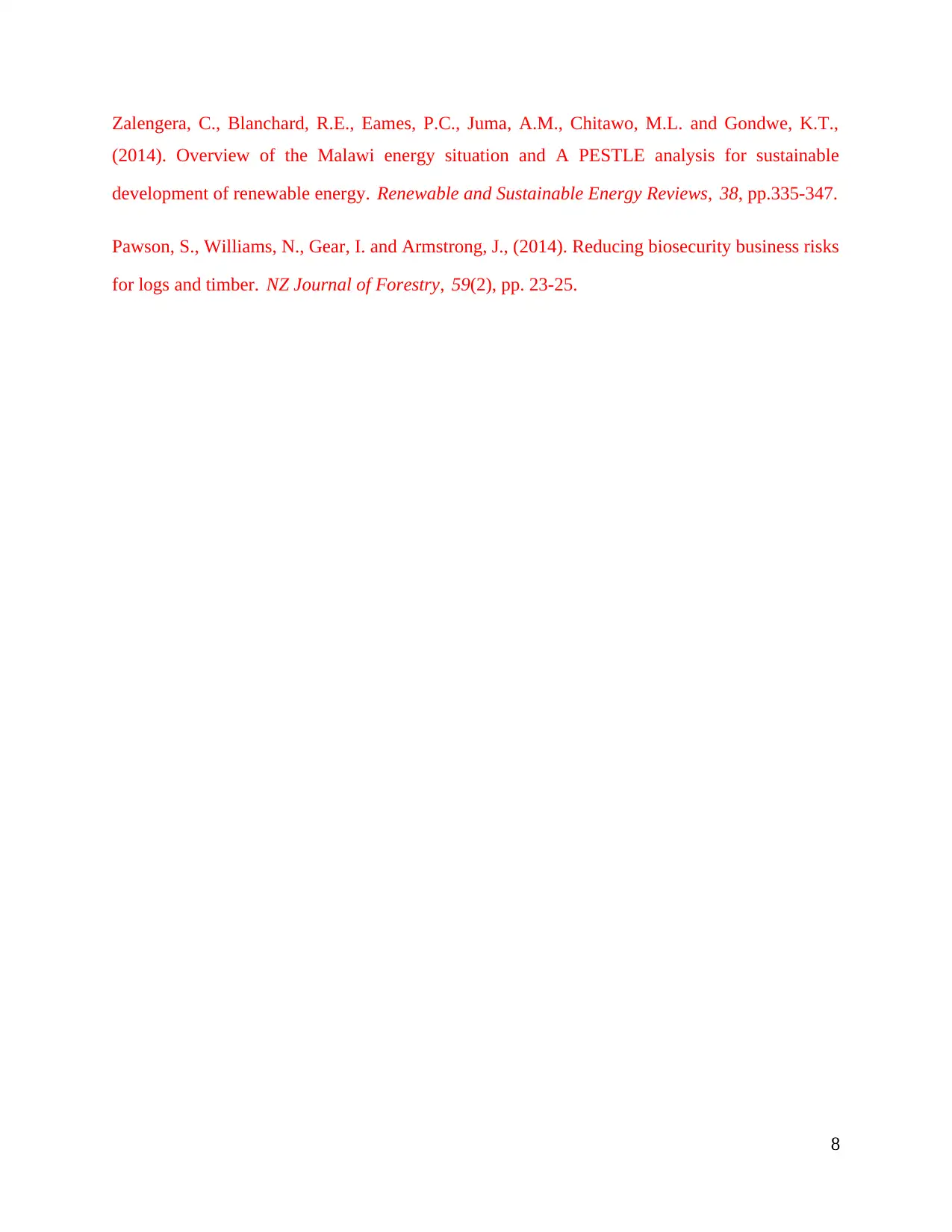
Zalengera, C., Blanchard, R.E., Eames, P.C., Juma, A.M., Chitawo, M.L. and Gondwe, K.T.,
(2014). Overview of the Malawi energy situation and A PESTLE analysis for sustainable
development of renewable energy. Renewable and Sustainable Energy Reviews, 38, pp.335-347.
Pawson, S., Williams, N., Gear, I. and Armstrong, J., (2014). Reducing biosecurity business risks
for logs and timber. NZ Journal of Forestry, 59(2), pp. 23-25.
8
(2014). Overview of the Malawi energy situation and A PESTLE analysis for sustainable
development of renewable energy. Renewable and Sustainable Energy Reviews, 38, pp.335-347.
Pawson, S., Williams, N., Gear, I. and Armstrong, J., (2014). Reducing biosecurity business risks
for logs and timber. NZ Journal of Forestry, 59(2), pp. 23-25.
8
1 out of 8
Related Documents
Your All-in-One AI-Powered Toolkit for Academic Success.
+13062052269
info@desklib.com
Available 24*7 on WhatsApp / Email
![[object Object]](/_next/static/media/star-bottom.7253800d.svg)
Unlock your academic potential
Copyright © 2020–2025 A2Z Services. All Rights Reserved. Developed and managed by ZUCOL.



